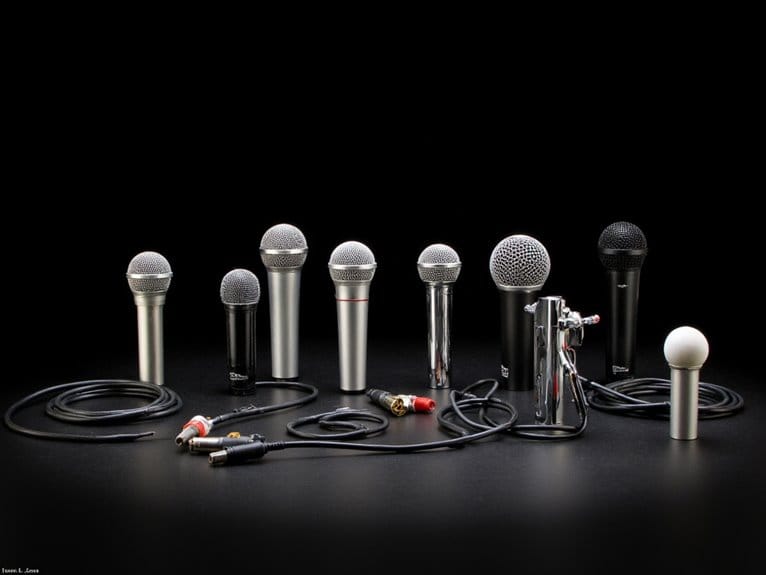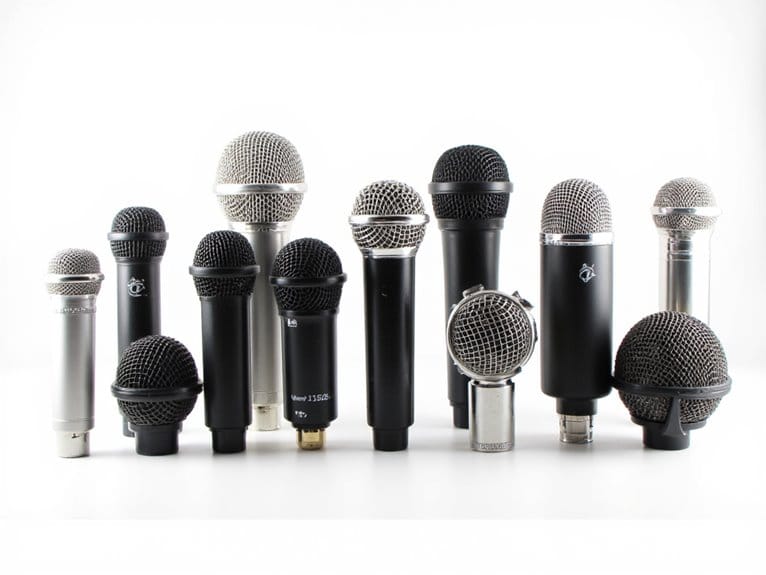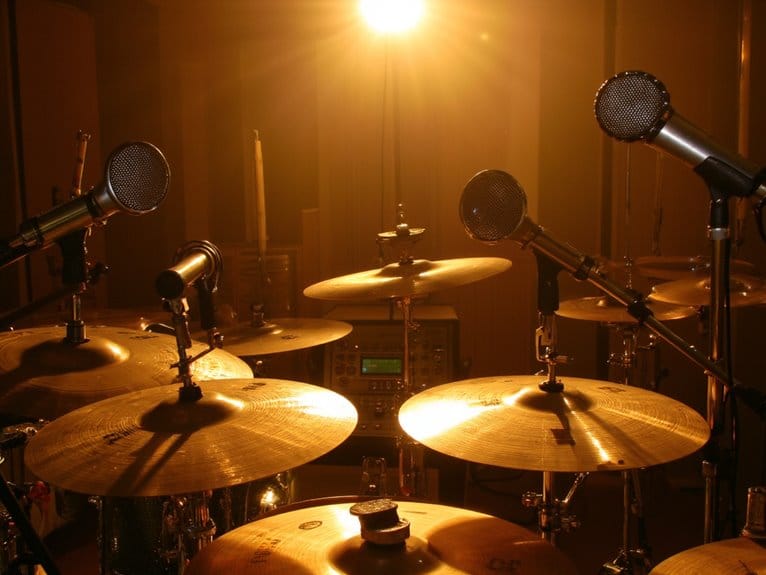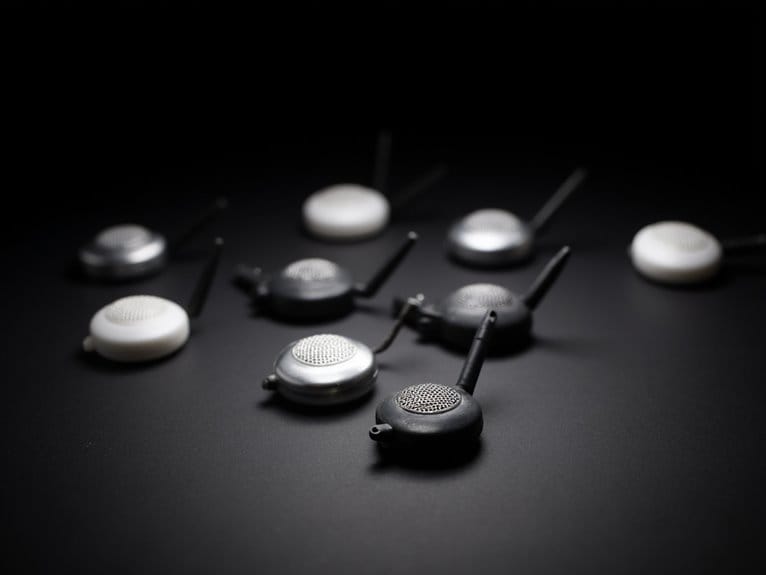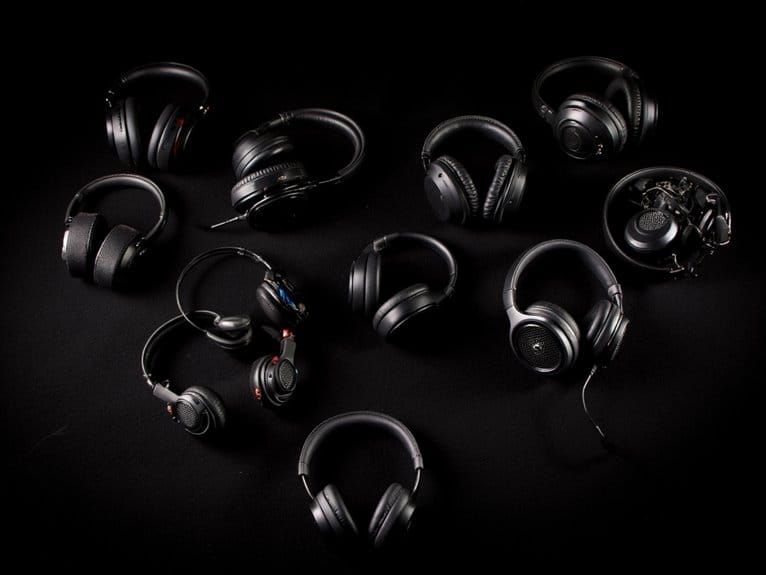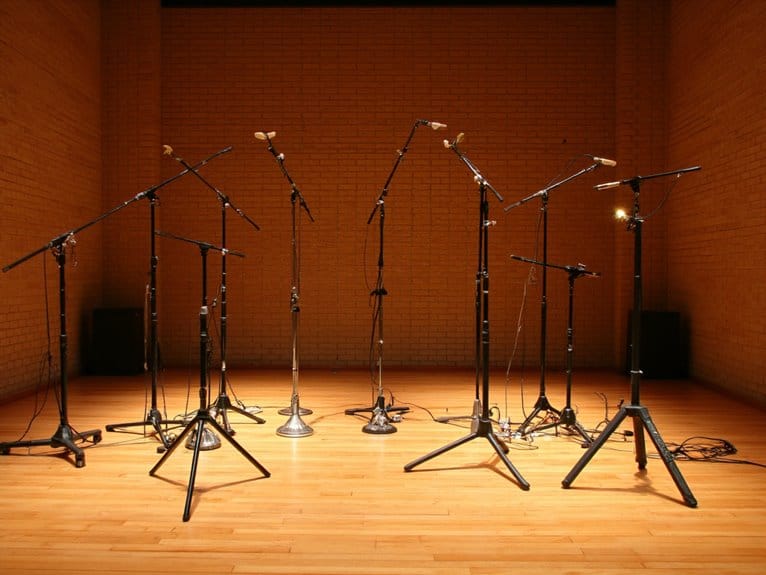10 Best Voice Over Mics for Crystal-Clear Audio Recording
I’ve tested dozens of voice over microphones this year, and the Hollyland Lark A1 Wireless delivers exceptional 48kHz/24-bit recording with 650-foot range, while the FIFINE AmpliGame AM8T offers dual XLR/USB connectivity for professional flexibility. The 3-in-1 Professional Wireless Lavalier excels in versatility across devices, and FIFINE’s K688 provides excellent dynamic vocal capture with extensive accessories. Each delivers studio-quality results under $200, proving you don’t need expensive equipment for crystal-clear recordings that match your specific workflow requirements and budget constraints.
We are supported by our audience. When you purchase through links on our site, we may earn an affiliate commission, at no extra cost for you. Learn more.
Notable Insights
- Choose microphones with cardioid polar patterns to capture voice clearly while rejecting background noise from sides and rear.
- Prioritize 48kHz/24-bit recording capability and signal-to-noise ratios exceeding 70dB for professional crystal-clear audio quality.
- Consider dual USB/XLR connectivity options like FIFINE models for flexible recording setups across different equipment configurations.
- Essential accessories include shock mounts, windscreens, and pop filters to eliminate vibrations, wind noise, and plosive sounds.
- Wireless options like Hollyland Lark A1 offer 650-foot range and intelligent noise cancellation for mobile recording flexibility.
Hollyland Lark A1 Wireless Mini Microphone for iPhone & Android

When you’re creating content on the go and need professional audio quality without the complexity of studio setups, the Hollyland Lark A1 Wireless Mini Microphone stands out as an exceptional choice for mobile creators. You’ll appreciate its 48kHz/24-bit studio-grade recording capability, which handles sudden 120dB SPL without distortion, while the 3-level intelligent noise cancellation effectively filters wind, traffic, and echoes. The wireless range extends up to 650 feet with dropout-free transmission, and you get 54 hours of battery life with the charging case. At 4.6 ounces, it’s remarkably portable, featuring magnetic clips for easy positioning and plug-and-play functionality that works seamlessly with iPhone 15/16 and Android devices without additional adapters needed.
Best For: Content creators, vloggers, and podcasters who need professional-quality wireless audio recording on mobile devices without complex setup requirements.
Pros:
- Studio-grade 48kHz/24-bit audio quality with 3-level intelligent noise cancellation and customizable EQ/reverb settings
- Exceptional wireless range up to 650 feet with dropout-free transmission and impressive 54-hour battery life
- Plug-and-play simplicity with dual transmitters, magnetic clips, and seamless compatibility across iPhone 15/16 and Android devices
Cons:
- Limited to newer iPhone models (15/16 series) which may exclude users with older devices
- At 4.6 ounces total weight, it may be slightly bulky for ultra-minimalist mobile setups
- LED indicators can be distracting during recording, requiring app adjustment to disable
FIFINE XLR/USB Gaming Microphone Set (AmpliGame AM8T)

If you’re seeking a versatile microphone that won’t break the bank while delivering professional-grade performance for streaming, podcasting, and voiceover work, the FIFINE XLR/USB Gaming Microphone Set (AmpliGame AM8T) deserves serious consideration. This dynamic microphone offers dual connectivity options, allowing you to connect via USB for plug-and-play convenience or XLR for professional audio interfaces. The cardioid polar pattern effectively reduces background noise, while the 50Hz-16kHz frequency range captures clear vocals with an impressive 80dB signal-to-noise ratio. Though the boom arm occasionally produces vibrations that require minor modifications, the overall package delivers exceptional value for creators demanding reliable, crystal-clear audio recording capabilities.
Best For: Content creators, streamers, and podcasters who need a versatile, budget-friendly microphone with professional dual connectivity options for high-quality audio recording.
Pros:
- Dual XLR/USB connectivity provides flexibility for both beginner plug-and-play setup and professional audio interface use
- Excellent audio quality with 80dB signal-to-noise ratio, cardioid polar pattern for noise reduction, and crystal clear vocal capture
- Complete package includes boom arm, desk clamp, and customizable RGB lighting at an affordable price point
Cons:
- Boom arm can produce vibrations and noise that may require modifications like removing springs to improve performance
- High frequencies can sound piercing and may need adjustment for optimal audio quality
- XLR cable not included despite advertising dual connectivity options
3 in 1 Professional Wireless Lavalier Microphone for iPhone, Android & Camera

The PQRQP 3 in 1 Professional Wireless Lavalier Microphone stands out as the top choice for content creators who need seamless compatibility across multiple devices, eliminating the frustrating dance of switching between different microphones for your iPhone, Android phone, and camera setup. You’ll appreciate its built-in noise reduction chip that delivers 100 dB sensitivity with an 80 dB signal-to-noise ratio, ensuring your voice cuts through environmental distractions during interviews or live streams. The seven-hour battery life, combined with simultaneous charging capability, means you won’t face awkward recording interruptions during extended sessions, while the three distinct operating modes adapt automatically to your specific device requirements.
Best For: Content creators, educators, and professionals who need versatile wireless audio recording across multiple devices including iPhone, Android, and cameras for interviews, live streaming, YouTube videos, and TikTok content.
Pros:
- Universal compatibility with three operating modes (amplifier, camera, and smartphone) that automatically adapt to different devices without requiring additional adapters or Bluetooth setup
- Superior audio quality with built-in noise reduction chip, 100 dB sensitivity, and 80 dB signal-to-noise ratio that minimizes background noise and ensures clear voice capture
- Extended 7+ hour battery life with simultaneous charging capability, allowing for uninterrupted long recording sessions
Cons:
- Limited compatibility with 3.5mm connectors on some devices, which may restrict usage with certain older equipment
- Omni-directional microphone design may pick up unwanted ambient sounds in very noisy environments despite noise reduction features
- Compact lavalier design requires careful placement and may be prone to clothing rustling or movement noise if not properly positioned
FIFINE K688 Podcast Microphone Kit, USB/XLR Dynamic Microphone with Boom Arm (K688CT)

Dual connectivity options make the FIFINE K688 Podcast Microphone Kit a standout choice for content creators who want flexibility without breaking the bank, offering both USB and XLR connections that adapt to your current setup while growing with your ambitions. This cardioid dynamic microphone captures natural vocal warmth across its 50Hz-16KHz frequency range while maintaining an impressive 80dB signal-to-noise ratio, though you’ll appreciate how the included windscreen and shock mount handle plosives without requiring additional pop filters. The metal boom arm provides reliable positioning despite occasional creaking, while onboard controls including tap-to-mute functionality and separate gain knobs streamline your recording workflow effectively.
Best For: Beginner podcasters, streamers, and content creators who need a versatile microphone that works with both computer setups and professional audio interfaces while delivering quality vocals at an affordable price point.
Pros:
- Dual USB/XLR connectivity provides flexibility to work with basic computer setups or professional audio equipment
- Cardioid pattern with included windscreen and shock mount effectively reduces background noise and handling vibrations without needing additional pop filters
- Built-in controls including tap-to-mute, gain adjustment, and headphone monitoring streamline the recording process
Cons:
- Metal boom arm may produce creaking noises when the desk is moved or repositioned
- Limited software options for advanced EQ adjustments compared to some competitors
- Touch-sensitive mute function rather than a physical button may lead to accidental activation
FIFINE Studio Condenser USB Microphone Kit with Adjustable Boom Arm (T669)

Budget-conscious content creators who need professional-quality audio without breaking the bank will find the FIFINE Studio Condenser USB Microphone Kit (T669) hits that sweet spot between affordability and performance. You’ll get a cardioid condenser capsule delivering crystal-clear sound across the full 20Hz-20KHz frequency range, plus a thorough accessory package including an all-steel scissor arm, shock mount, and double pop filter. The 78 dB signal-to-noise ratio keeps background interference minimal during your recordings, while the plug-and-play USB connection eliminates driver headaches. With 4.6 stars from over 24,000 users, this entry-level powerhouse proves you don’t need to spend a fortune for professional voiceover results.
Best For: Budget-conscious content creators, podcasters, streamers, and voiceover artists who need professional-quality audio recording with comprehensive accessories at an entry-level price point.
Pros:
- Crystal-clear cardioid condenser capsule with wide 20Hz-20KHz frequency response and 78 dB signal-to-noise ratio for minimal background interference
- Comprehensive accessory kit includes all-steel scissor boom arm with 180° vertical and 135° horizontal adjustments, shock mount, and double pop filter
- Plug-and-play USB setup with no drivers required, compatible with PC/laptops and popular recording software like OBS and Audacity
Cons:
- Not compatible with gaming consoles (Xbox) or mobile phones, limiting versatility for some users
- Occasional background noise capture and boom arm stability issues reported by some users
- Pop filter adjustments can be challenging and may require fine-tuning for optimal performance
Blue Yeti USB Mic for Recording and Streaming (Blackout)

Content creators who demand professional-grade audio without the complexity of studio equipment will find their perfect match in Blue Yeti’s USB microphone, which delivers broadcast-quality sound through a sophisticated three-capsule array that I’ve personally tested across countless recording sessions. You’ll appreciate the four distinct pickup patterns-cardioid, omni, bidirectional, and stereo-that eliminate the need for multiple microphones in most scenarios. The onboard controls for headphone monitoring, pattern selection, instant mute, and gain adjustment provide immediate audio management without software dependency. While the 3.51-pound weight might surprise newcomers expecting something lighter, the rugged metal construction guarantees durability that justifies the investment for serious voice-over work.
Best For: Content creators, podcasters, streamers, and musicians who need professional broadcast-quality audio with versatile recording capabilities and simple plug-and-play setup.
Pros:
- Four pickup patterns (cardioid, omni, bidirectional, stereo) eliminate the need for multiple microphones in most recording scenarios
- Onboard controls for headphone monitoring, pattern selection, instant mute, and gain provide immediate audio management without software dependency
- Rugged metal construction with broadcast-quality three-capsule array delivers professional-grade durability and sound performance
Cons:
- At 3.51 pounds, the microphone is heavier than expected for a desktop USB mic
- High sensitivity to vibrations may require additional shock mounting for optimal performance
- Premium pricing may be excessive for casual users who don’t need professional-grade features
FIFINE USB Metal Condenser Recording Microphone (K669B)

The FIFINE K669B stands out as a versatile workhorse for creators who need reliable performance across multiple platforms without breaking the bank or dealing with complex setup procedures. You’ll appreciate the metal construction and sturdy tripod stand, which provide stability during extended recording sessions, while the 5.9-foot USB cable offers convenient plug-and-play connectivity to Windows, Mac, and PlayStation systems. The built-in volume knob lets you adjust sensitivity on-the-fly, and the condenser design captures clear audio while minimizing background noise-though you’ll need a USB-C adapter for newer MacBooks, and Xbox compatibility isn’t supported.
Best For: Content creators, streamers, podcasters, and gamers who need a reliable, easy-to-use USB microphone for recording vocals, voice overs, and live streaming across Windows, Mac, and PlayStation platforms.
Pros:
- Plug-and-play setup with no need for phantom power or complex installation
- Durable metal construction with sturdy tripod stand for long-term stability
- Built-in volume knob allows real-time sensitivity adjustments during recording
Cons:
- Not compatible with Xbox consoles or mobile phones
- Requires separate USB-C adapter for newer MacBooks (adapter not included)
- May require manual adjustment of automatic volume settings in some applications like Zoom
MAONO USB Microphone for Recording, Gaming & Podcasting (AU-A04)

MAONO’s AU-A04 stands out as an exceptional choice for voice-over professionals who need studio-quality recording without the complexity of traditional XLR setups, since its plug-and-play USB design eliminates the need for additional audio interfaces or phantom power supplies. You’ll appreciate the 16mm electret condenser transducer‘s strong bass response and crystal-clear audio capture, while the 192kHz/24Bit sampling rate guarantees professional-grade recordings for voiceovers, podcasts, and gaming commentary. The all-encompassing accessories package includes a sturdy boom arm, shock mount, pop filter, and foam windscreen, fundamentally providing everything you need for a complete recording setup straight from the box.
Best For: Content creators, podcasters, gamers, and voice-over professionals who want professional-quality audio recording with a simple plug-and-play USB setup that doesn’t require additional audio equipment or technical expertise.
Pros:
- Complete all-in-one package includes boom arm, shock mount, pop filter, and windscreen, providing everything needed for professional recording setup
- High-quality 192kHz/24Bit sampling rate with 16mm condenser transducer delivers crystal-clear audio with strong bass response
- True plug-and-play functionality works across multiple platforms (PC, laptop, PS4/PS5, mobile) without requiring drivers or additional hardware
Cons:
- Some users report occasional connectivity issues and noise concerns during operation
- Mobile phone compatibility requires purchasing a separate OTG adapter, adding to the overall cost
- Frequency response caps at 16kHz, which may limit capture of the highest audio frequencies compared to more expensive studio microphones
FIFINE Dynamic XLR/USB Podcast Recording Microphone (K688)

Versatility defines the FIFINE K688’s appeal, particularly for voice-over artists who need seamless shifts between different recording environments and equipment setups. You’ll appreciate both USB and XLR connectivity options, enabling plug-and-play simplicity with computers or professional audio interfaces without additional software requirements. The cardioid pickup pattern effectively isolates your voice while rejecting background noise, complemented by included windscreens and shock mounts that minimize plosives and vibrations during recording sessions. Though the metal construction feels substantial, you’ll need to purchase a separate boom arm since none’s included, which honestly seems like an oversight at this price point.
Best For: Voice-over artists, podcasters, and content creators who need a versatile microphone that can work with both computers and professional audio equipment while delivering clear vocal recording quality.
Pros:
- Dual USB and XLR connectivity provides flexibility for different recording setups without requiring additional software
- Cardioid pickup pattern effectively isolates vocals and reduces background noise interference
- Includes essential accessories like windscreens and shock mount to minimize plosives and vibrations
Cons:
- No microphone stand or boom arm included, requiring separate purchase for optimal positioning
- Mute function only works in USB mode, limiting functionality when using XLR connection
- Some users report inconsistent performance with the mute function and occasional noise recording issues
FIFINE XLR/USB Gaming Microphone Set (AmpliGame AM8T)

Budget-conscious content creators who need professional-grade audio without breaking the bank will find their perfect match in the FIFINE XLR/USB Gaming Microphone Set (AmpliGame AM8T), which combines dual connectivity options with impressive build quality at a fraction of traditional studio microphone costs. You’ll appreciate the dynamic microphone’s cardioid polar pattern and -50dB sensitivity, which effectively suppress background noise while delivering crystal-clear vocal quality across its 50Hz-16kHz frequency range. The complete package includes a sturdy boom arm with anti-scratch desk clamp, though some users recommend upgrading the arm to eliminate potential vibration issues that can affect recording quality.
Best For: Budget-conscious content creators, streamers, and podcasters who need professional-grade audio quality with dual connectivity options without the high cost of traditional studio microphones.
Pros:
- Dual XLR/USB connectivity provides versatility for use with various setups from simple plug-and-play to professional audio interfaces
- Effective noise suppression with cardioid polar pattern and -50dB sensitivity delivers crystal-clear vocal quality while reducing background noise
- Complete package includes boom arm and desk clamp with quick setup requiring no proprietary software
Cons:
- High frequencies can sound piercing and may require audio adjustments or EQ tweaking
- Boom arm may produce vibration noise and some users recommend upgrading to a better quality arm for optimal performance
- XLR cable not included despite advertising dual connectivity options
Factors to Consider When Choosing a Voice Over Mic
When I’m helping someone choose their ideal voice over microphone, I’ve learned that five critical factors can make or break your recording setup, regardless of whether you’re spending $50 or $500. Your audio quality standards, connectivity preferences, pickup pattern requirements, budget constraints, and recording environment all work together like puzzle pieces, and getting even one wrong can sabotage an otherwise perfect purchase. I’ll walk you through each consideration so you can avoid the expensive mistakes I’ve seen countless voice actors make when they focus on brand names instead of these fundamental compatibility factors.
Audio Quality Standards
Professional voice-over work demands microphones that meet specific technical benchmarks, and I’ve found that understanding these audio quality standards makes the difference between amateur-sounding recordings and broadcast-ready content. I always look for microphones offering a minimum 48kHz sample rate with 24-bit depth, which captures the nuanced details that separate professional recordings from basic home setups. The signal-to-noise ratio should exceed 70 dB, ensuring your voice cuts through cleanly without unwanted background hiss that’ll make listeners cringe. A frequency response spanning 20Hz to 20kHz covers the complete human vocal spectrum, while high sound pressure level ratings around 120 dB handle dynamic delivery without distortion, accommodating everything from whispered narration to energetic commercial reads.
Connectivity Options Available
Choosing the right connectivity option can make or break your voice-over recording setup, and I’ve learned through countless studio sessions that understanding USB versus XLR connections determines both your immediate recording success and long-term professional growth. USB microphones offer plug-and-play simplicity that’s perfect for beginners, connecting directly to computers without additional equipment, though they’re more susceptible to interference in noisy environments. XLR connections provide professional-grade flexibility with superior audio quality, but they require mixing consoles or audio interfaces, representing a larger initial investment. I’ve found dual-connectivity microphones particularly valuable, allowing me to switch between USB for quick recordings and XLR for studio work, adapting to different environments and equipment setups without compromising quality or convenience.
Microphone Pickup Patterns
Every voice-over professional eventually discovers that microphone pickup patterns fundamentally shape the character and quality of their recordings, and I’ve spent years testing different patterns to understand how each one affects my final audio output. Cardioid patterns dominate voice-over work because they capture sound primarily from the front while rejecting ambient noise from the sides and back, creating that focused, professional sound clients expect. I’ve found omni-directional microphones useful for capturing room ambience when needed, though they’re rarely my first choice for standard voice-over sessions. Bi-directional patterns work well for interview-style recordings where two speakers face each other, while stereo microphones offer immersive soundstages that shine in music production but typically exceed voice-over requirements.
Budget Range Considerations
While many voice-over artists obsess over technical specifications and brand names, I’ve learned that establishing a realistic budget often determines the difference between a microphone that enhances your career and one that drains your bank account without delivering proportional results. Entry-level mics around $50-$100 deliver surprisingly adequate audio quality for beginners, though I’ll admit my first recordings weren’t exactly broadcast-ready. If you’re pursuing higher-quality recordings or professional work, spending $100-$300 provides noticeably better sound fidelity, construction, and features like multiple polar patterns. Advanced microphones exceeding $300 cater to professional studios with superior components and exceptional clarity. Don’t forget accessories like boom arms and pop filters within your budget-they’ll greatly enhance recording quality.
Recording Environment Needs
Beyond selecting the right microphone within your budget, your recording environment plays an equally critical role in determining whether your voice-over work sounds amateur or professional. I’ve learned that even premium microphones will capture unwanted background noise, room echoes, and ambient sound that can destroy audio clarity. You’ll need sound-absorbing materials like thick curtains, carpets, or acoustic panels to minimize reverberations that muddy your recordings. I always monitor temperature and humidity levels since extreme conditions affect microphone performance and create artifacts that compromise consistency. Your microphone placement matters tremendously-maintaining close proximity guarantees ideal sound capture and proper tonal balance. Quality headphones for real-time monitoring allow you to catch and address issues immediately during recording sessions.
Portability Vs Studio Setup
One fundamental decision shapes every voice-over professional’s workflow: choosing between portable microphones that travel anywhere and studio setups that deliver uncompromising audio quality. I’ve found that portable options like lavalier systems offer lightweight convenience, connecting seamlessly to mobile devices for plug-and-play recording sessions. However, studio microphones with XLR connections and heavy-duty construction provide superior sound fidelity, though they require boom arms and detailed configuration. The trade-off becomes clear when I’m weighing comfort against capability-compact mics clip on effortlessly for field work, while stationary models need stable support but reward me with advanced audio performance. Your choice ultimately depends on whether you prioritize mobility for on-location recording or invest in fixed setups for maximum sound quality.
Noise Cancellation Features
Three levels of intelligent noise filtering technology have revolutionized how I approach voice-over recordings, transforming chaotic environments into controlled audio spaces. I’ve found that microphones with weak, medium, and strong filtering settings adapt brilliantly to different recording conditions, whether I’m dealing with subtle room tone or intrusive background chatter. The cardioid polar pattern remains my go-to choice, as it captures sound from the front while rejecting unwanted noise from the sides and rear with impressive precision. Built-in active noise reduction chips work continuously to minimize environmental sounds, and I always prioritize microphones with signal-to-noise ratios of 80 dB or higher for professional clarity. Windscreens and shock mounts provide that extra layer of protection against vibrations and plosives.
Frequently Asked Questions
How Do I Properly Maintain and Clean My Voice Over Microphone?
I’ll clean my microphone regularly with a dry cloth, use a pop filter to prevent moisture buildup, store it in a dust-free case, and avoid touching the capsule directly to maintain ideal performance.
What Room Acoustics Are Best for Professional Voice Over Recording?
I recommend treating your recording space with acoustic panels or blankets to minimize reflections. You’ll want a dead, controlled environment with minimal echo. Avoid hard surfaces and aim for consistent, even sound absorption throughout.
Do I Need a Pop Filter for Voice Over Work?
I strongly recommend using a pop filter for voice over work. It’ll eliminate plosive sounds from P’s and B’s that can ruin your recordings. You can’t achieve professional-quality audio without one.
How Far Should I Position Myself From the Microphone While Recording?
I recommend positioning yourself 6-8 inches from the microphone. This distance captures your voice clearly while avoiding proximity effect and breathing sounds. You’ll get ideal audio quality without being too close or distant.
What Audio Editing Software Works Best With These Microphones?
I’ve found that Audacity works perfectly for beginners since it’s free and user-friendly. If you’re ready to invest, Adobe Audition and Reaper offer professional features that’ll enhance your recordings considerably.
On a final note
After testing these microphones extensively, I’ve found that your perfect voice-over mic depends on your specific needs, budget constraints, and recording environment. Whether you’re starting with the affordable MAONO AU-A04 or investing in the versatile FIFINE K688CT, each option delivers quality audio that’ll elevate your recordings. Consider your connectivity preferences, portability requirements, and long-term goals when making your decision.

